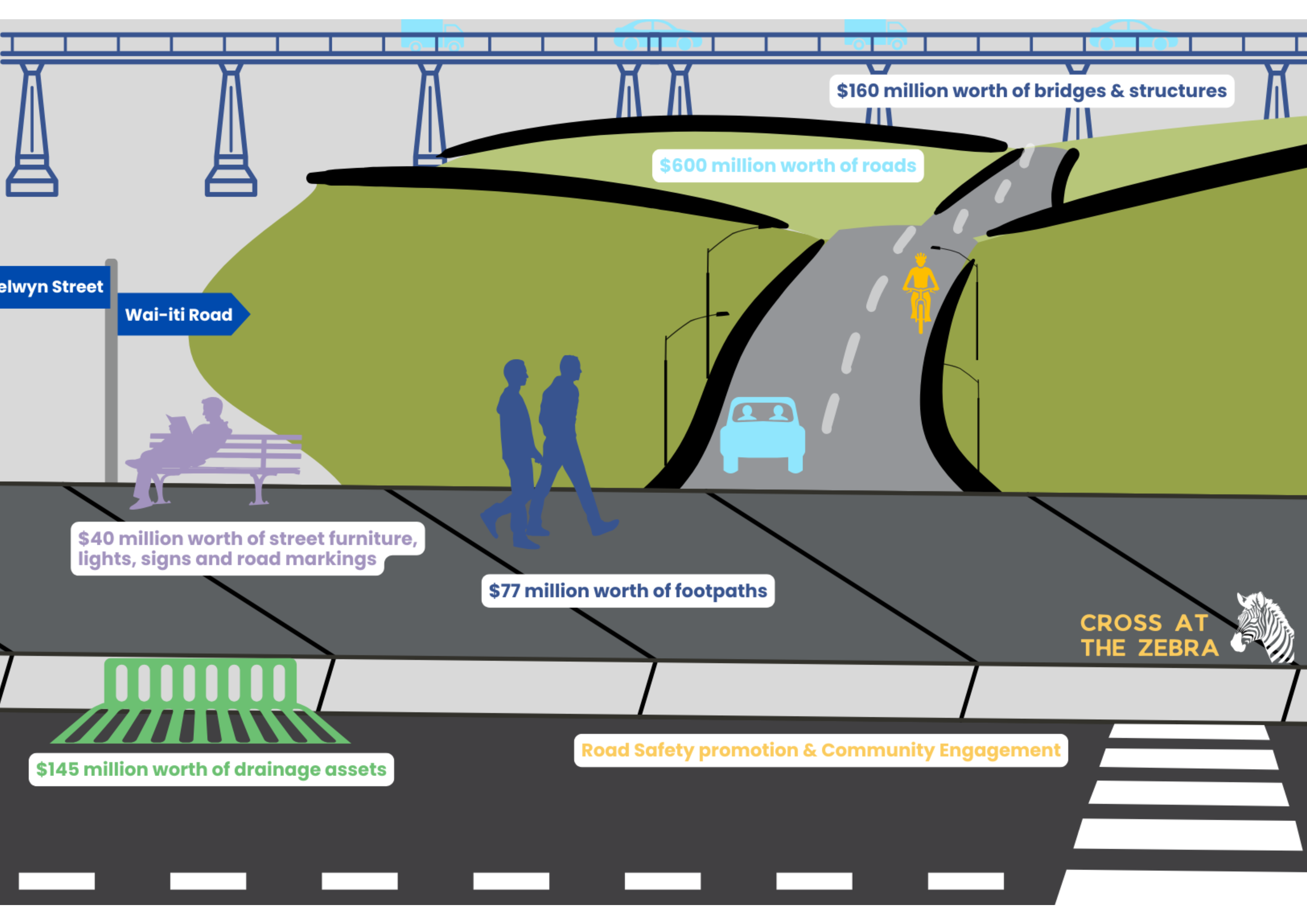What is Council responsible for?
Council is responsible for providing and maintaining a wide range of road network assets within the district, including:
- $600 million worth of roads (excluding the State Highway network)
- $160 million worth of bridges and structures
- $145 million worth of drainage assets
- $77 million worth of footpaths
- $40 million worth of street furniture, lighting, signage, and road markings
A dedicated Land Transport Unit within Council manages these assets, and also leads road safety promotions across the motu.
Reporting an issue about one of our road network assets is easy – click here to find out how
What work do we do?
Roads
Council manages 1700km of roads, 57% sealed and 43% unsealed. Council upholds a programme of works to maintain the roads, with prioritisation based on a number of factors.
Bridges
Council manages 176 bridges, 147 large culverts, 25 retaining walls, 57 concrete fords and 12,700m of railings in the Timaru District, and each year, some of these bridges are earmarked for replacement, maintenance, reinforcing, upgrade and other works. There are a number of historical bridges in the District.
Click here to find out which bridges are weight and speed limited.
Footpaths
Council maintains about 350km of footpaths in the District. The District's footpaths provide a safe and convenient space for pedestrians, especially in urban areas. Footpaths enable pedestrians to get to and from their place to work, school, and even move around the community for social, sporting, work, and other needs. A safe and effective footpath network helps the environment by encouraging people to walk or jog to their destinations rather than taking their motor vehicle.
General maintenance of footpaths is delivered to ensure the footpaths are well maintained, clean, and in a safe condition.
Street furniture
Street furniture includes seating and benches, bus shelters, bike stands, planter boxes, street banners, christmas decorations, some fences in the CBD, balustrades and bollards. Council makes sure that these are well planned and managed, and maintained to be safe, clean, and able to cope with future needs.
Street lights
Council installs, maintains, and upgrades different types of street lights in the District:
- Road lights;
- Pedestrian crossing lights (belisha beacons);
- Lighting in the parks and reserves areas;
- Pedestrian access way lights.
All street lights in private lanes or right-of-ways are installed and maintained by private landowners. Council does maintain the street lights on state highways in the Timaru District on behalf of the New Zealand Transport Agency.
Traffic lights/signals
Traffic signals are installed to manage traffic flows and improve accessibility and safety for drivers, pedestrians and cyclists. In some instances traffic signals may also be used to support a disability need.
Council is commonly asked why roundabouts are not installed at some intersections. Typically roundabouts only work well when traffic flows are balanced, and where there is little demand for pedestrian or cycle facilities. At certain sites traffic signals are thus the safest method to control traffic and protect all road users – including cyclists and pedestrians.
Street signs
There are many types of street/road signs:
- Compulsory/regulatory signs – these advise drivers of restrictions and include speed limit, stop and parking restriction signs
- Temporary warning signs – these alert drivers of temporary hazards on the road ahead, such as road works, lane closures and gravel surfaces.
- Permanent warning signs – these indicate to drivers of the presence of road hazards such as curves, speed bumps and school zones
- Information signs – these provide useful information such as distance to the next town or rest areas
- Street name signs – these are blue with white writing and indicate street names throughout the District
- Amenity signs – these provide direction to certain public organisations and amenities such as schools, churches and community centres.
Private lanes/right-of-ways belonging to property owners are not maintained by Council. These signs can be distinguished as they have blue lettering on a white background (the reverse of a standard street name sign).
Road markings
Road markings are frequently maintained by Council to meet the needs of people and communities to avoid any hazards or danger to pedestrians and vehicles. The road markings shall comply with the New Zealand Transport Agency Specifications, New Zealand Standards, and Council's Delineation Standards.
Parking facilities
Council manages many parking facilities across the District. You can read more about parking here.
Key strategies and plans
Below you can download some of our key strategies and plans – these documents contain more information about the work we do and how we do it.
Land Transport Activity and Asset Management Plan 2024-34
This document sets out our 10 year programme for managing roading assets.
Onwards: Timaru District Active Transport Strategy 2024
This document sets out our plans to improve walking, cycling and mobility infrastructure and outcomes in the Timaru District.
Bylaws are local legislation enforceable by Council staff and other nominated agencies. Several local bylaws are related to management of roads and footpaths in the District.
This page includes the current policy related to the management of roads and footpaths in the District.
Last updated: 23 Jun 2025